Text
Andromeda in all its glory

12 hours of total exposure were used to develop this picture of M31 our galactic neighbor in roughly 2.5 million lightyears distance.
Bilddaten:
- 98 x 300 / RGB
- 33 x 480 / DualNarrow
- 25 Flats
- 25 Flat Dark
- 25 Darks
Setup:
- Skywatcher 72ED f6
- Omegon 571C
- Skywatcher EQ6R Pro
- Zwo Asi 178mm als Guide cam
77 notes
·
View notes
Text
Such a long journey

Every 71 years visits this comet called 12P Pons Brooks the inner solar system and passes the sun. At the moment he is close to the sun which leads to its Coma and tail.
I capture it with 51 frames each exposed for 30s.
#astronomy#universe#space#space photography#astrophotography#night sky#astrophysics#nature#comet#comet 12p/pons brooks
59 notes
·
View notes
Text
Skull or Rosette?

This beautiful emission nebula in the constellation Unicorn with embedded star cluster NGC 2244 is a popular target in the winter starry sky. Parts of the nebula itself were first described by various astronomers between 1830 and 1886. The star cluster inside, however, was discovered as early as 1690.
With a distance of 5219 light years and a radius of 65 light years, it is almost in our neighborhood.
Translated with DeepL.com (free version)
73 notes
·
View notes
Text
The seven sisters

That's how it is in astronomy, sometimes the weather plays against you for weeks and then there are these unexpected gaps again.
The astro year was ticked off when the sky opened up on December 17th for almost a whole night and allowed me to take my first mosaic of a deep-sky object.
M45 or the Pleiades, this beautiful open star cluster in the constellation Taurus is now shown here as a mosaic of 2 panels taken with a 750mm Newtonian.
The spikes on the stars are simply one of the most beautiful optical errors of such a reflecting telescope and are deeply rooted in my generation through the Hubbel images from our childhood and youth.
264 notes
·
View notes
Text
Run checken run 🐓

From the category ... "you don't often see" an object from the southern sky today.
IC 2944 in the constellation Centaur contains not only quantities of ionized hydrogen (Halpha), oxygen (OIII) and sulphur (SII) but also so-called globules. These are the dark spots in the center and consist of dense molecular clouds in which new stars are formed.
In total, over 10.5 hours of data from a telescope in Chile were used here.
Image processed by Andreas Grelak, original data from Telescope Live
58 notes
·
View notes
Text
Fast traveler

Since March 2022 astromers observing comet C2022 E3 ZTF and over the next month it gets more probably that this will be the next great Comet after Neowise and Leonard.
I had the chance to capture it in early 2023 and this is his movement during those 90minutes.
97 notes
·
View notes
Text
Partial Moon Eclipse

There was a partial solar eclipse on October 28. Even though the Earth's shadow only covered about 10% of the full moon at my latitude, the effect was still clearly visible.
And the fact that the rain-heavy clouds cleared for exactly these 90 minutes made this evening so special.
84 notes
·
View notes
Text
Skyshark
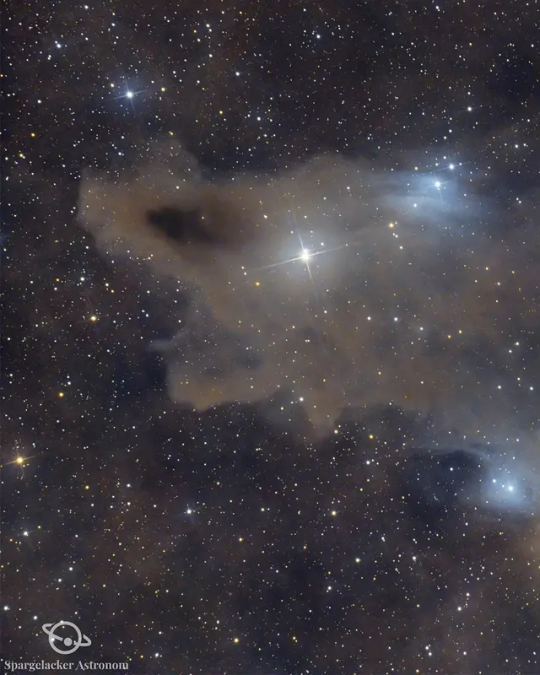
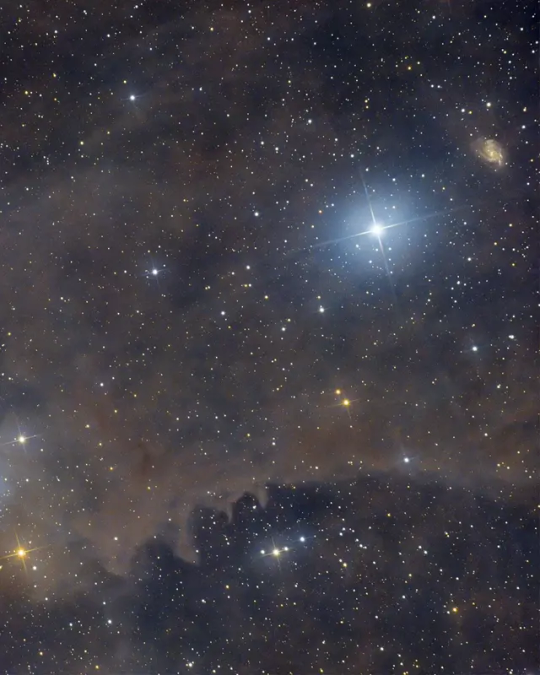
Man sees what he wants to see, and so it is with the Dark Nebula LDN 1235. This collection of dust in the constellation Cepheus is very reminiscent of a shark. At just 650 light years away, it is just around the corner.
Object type: Dark nebula
Constellation: Cepheus
Total exposure: 720 minutes
Image data:
- RGB 144 x 300s / Gain 100
- 25 flats
- 25 Bias
- 25 Darks
Setup:
- Skywatcher 150/750 F5 PDS
- Omegon 571C
- Skywatcher EQ6R Pro
- Two Asi 178mm as guide cam
134 notes
·
View notes
Text
Pelican nebula IC 5070

IC 5070 or the Pelican Nebula one of the more prominent parts of the many nebulae in the area of the constellation Swan.
These extended nebulae of hydrogen and oxygen are located about 2000 light-years away and were already discovered by Max Wolf in 1891.
Object type: Emission nebula
Constellation: Swan / Cygnus
Total exposure: 576 minutes
103 notes
·
View notes
Text
View on an intergalactic elephant

IC 1396, the elephant's trunk in the constellation Cepheus is one of those photogenic nebulae that astrophotographers just can't resist.
At just under 2400 light years lie the gas clouds that dominate these regions.
60 notes
·
View notes
Text
The Universe at your wall

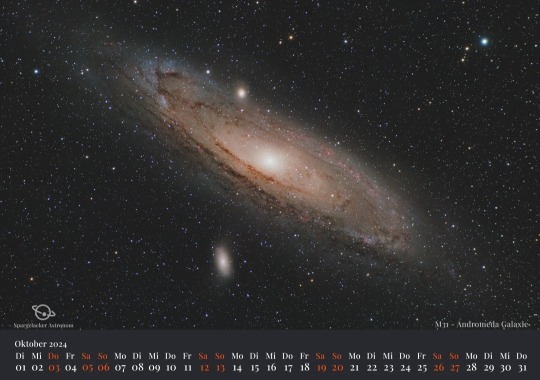
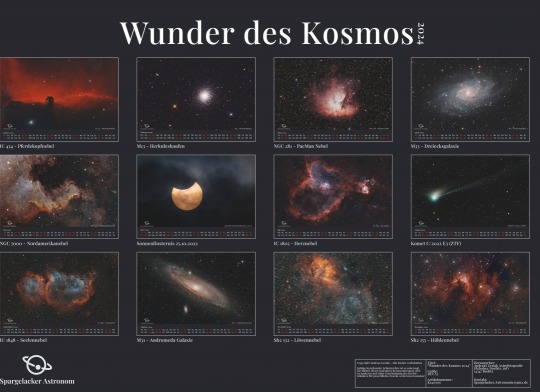
From now on my Calender 2024 is available. 13 astrophotographies of different objects in our universe. Each one captured by myself in my backyard. Dozens of hours of exposure time have gone into these images.
Available in two sizes, DIN A3 & A2.
For shipments outside of German speaking countries please get in contact, via my website or here.
https://www.spargelacker-astronom.de/product-page/wunder-des-kosmos-2024
#astronomy#universe#space#space photography#astrophotography#night sky#nature#calender#2024 calendar
72 notes
·
View notes
Text
Pinky & Brain

NGC6888 this also called Crescent Nebula in the constellation Swan is about 4700 light-years away from Earth.
In the center of the nebula lies the star WR 136, which belongs to the very special class of Wolf-Rayet stars.
Bilddaten:
- DualNarrow 15 x 480s / Gain 100
- RGB 12 x 300s / Gain 100
- 25 Flat Dark
- 25 Flat Darks
- 25 Darks
Setup:
- Skywatcher 150/750 F5 PDS
- Omegon 571C
- Skywatcher EQ6R Pro
- Zwo Asi 178mm als Guide cam
94 notes
·
View notes
Text

Today something different, because the nights are still too bright in my latitudes to do reasonable astrophotography.
So I took the opportunity to photograph this lightining during a small storm.
Thats a 10second exposure taken with a Canon R6 and a 16mm lense.
153 notes
·
View notes
Text
A stars end 21 Million lightyears distance


M101 and its currently very prominent supernova are a reason to put the setup outside even under adverse conditions.
It's not always about pretty pictures but also about all the fascinating insights and views that the sky gives us. It's this contrast of being in the same place forever and the events that manifest themselves within hours, days and weeks that captivates me so much.
So here now a star which exhales its life in more than 20 million light-years, thereby outshines the core of its home galaxy and this whole development is known to us only since 19.05 ... I love this universe
#astronomy#universe#space#space photography#astrophotography#astrophysics#night sky#supernova#messier101
224 notes
·
View notes
Text
So many stars
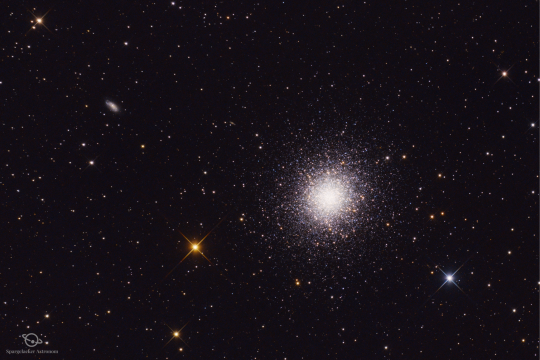
Messier 13 or the Hercules Cluster is one of the brightest clusters visible at the northern night sky. Roughly 500.000 stars are packed in this cluster which is 25000 lightyears away.
Bilddaten:
- RGB 34 x 300s / Gain 100
- 25 Flats
- 25 Bias
- 25 Darks
Setup:
- Skywatcher 150/750 F5 PDS
- Omegon 571C
- Skywatcher EQ6R Pro
- Zwo Asi 178mm als Guide cam
62 notes
·
View notes
Text
High in the skies

7 Persons watching down on the living humanity in this picture.
The ISS transited in front the sun and I was able capture this 1,6s lasting moment with a skywatcher 72ED and a ZWO 178MM.
#astronomy#universe#space#space photography#astrophotography#astrophysics#nature#ISS#sun photography#sun
77 notes
·
View notes
Text
Star crip in the constellation if Cepheus

Behold the Cave Nebula! 🌌 Also known as SH2-155, this stunning celestial wonder is a cloud of glowing gas and dust located 2,400 light-years away in the constellation Cepheus.
Its eerie blue and red hues are the result of ionized hydrogen and sulfur molecules interacting with starlight. Take a journey into the depths of the universe and marvel at the beauty of SH2-155! ✨🔭
Bilddaten
- LExtreme 25 x 480s / Gain 100
- RGB 59 x 300s / Gain 100
- 25 Flat Dark
- 25 Flat Darks
- 25 Darks
Setup:
- Skywatcher 150/750 F5 PDS
- Omegon 571C
- Skywatcher EQ6R Pro
- Zwo Asi 178mm als Guide cam
#astronomy#universe#space#space photography#astrophotography#night sky#astrophysics#nature#CaveNebula#SH2155
120 notes
·
View notes